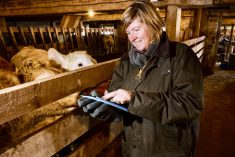It’s not easy to sell a business that you’ve poured your heart and soul into. And selling an agribusiness isn’t as simple as selling a piece of equipment or land.
Potential buyers must meet the owner’s criteria, often including that they must be a good bet to protect their legacy, which means they may also be scarce. You must also plan for the effects of the sale on customers, employees and the community.
Plus, of course, you want to close on a deal that provides the value your business is worth.
Read Also

It doesn’t have to be the end for your farm
Options for farmers without successors to pass on the farm.
How do you put a dollar amount on your life’s work? Work that has been a lifestyle, not necessarily based on rigid accounting processes, but rather on a lot of intuition, carefully nurtured relationships and on-the-ground experience.
It’s true that the value of a business’s worth lies mostly on its balance sheet and income statements. But the narrative — that is, its operations including customers, suppliers and markets — can affect the way those numbers are translated.
What does that mean? Let’s break it down.
If we tease out the term — “numbers narrative” — we can say that the “numbers” component is an objective. It’s a black-and-white reflection of the business’s financial past, present and future.
The ‘narrative’ component, by contrast, reflects its values and history. It’s the sum of the relationships with customers, suppliers, banks, etc., plus its operations, its products and its markets, all coalescing to form a powerful narrative that provides the context for the numbers.
While every business starts with a narrative — a story about the business that unfolds over time — the numbers are an equally important piece of that story throughout the farm’s decades of growth, particularly during the valuation stage.

When it comes to selling a business, it’s the combination of the two — number and narrative — and putting them together in one holistic term that offers the most complete perspective for a potential buyer.
“The data can validate the narrative,” says Lisa Courtney Lloyd, vice-president of business development at Market Maker Agriculture, a company that buys privately owned, seasonal agribusinesses. “Numbers give you power to understand your business regardless of what you want to do with it.”
Many business owners have their narrative down pat, though generally in their head. They know their values, goals and founding history; their customers, operations and products; their best-sellers.
“But how, where do you make your money?” asks Courtney Lloyd. “If you don’t know the business’s numbers you only have half the story.”
Whether you’re still growing the business or, like Market Maker Agriculture’s clients, you’re ready to sell, having only half the equation won’t give the answer — or the eventual value — you’re looking for.
Where do you make your money?
Even if you’re not looking to transition ownership of your agribusiness, Courtney Lloyd says that linking numbers and narrative together is key to continuing to build a strong business.
She suggests digging in to discover which are your business’s value streams, all of which can be analyzed in terms of both numbers and narrative.
“For example, if all you did was look at the numbers,” Courtney Lloyd says, “you might decide to get rid of a product because it doesn’t have a strong margin or it’s losing you money. But the narrative might indicate that this product is why customers come to you in the first place. That product is your competitive advantage. So, you need both.
“It’s like the famous business principle of ‘you can’t manage what you can’t measure.’ If you objectively measure the black and white numbers around that product, you might find it’s not making you the money you thought it was, but customers love it, and they keep coming back.”
As part of the value stream exercise, Courtney Lloyd says you should also determine your cost of production, which includes taking a close look at inventory.
Inventory affects your working capital and cash flow. This can be a huge risk, especially for seasonal businesses, and it can affect your valuation during the business sale process. “Many people don’t see inventory as money sitting in the yard, as part of the numbers component,” Courtney Lloyd explains.
“They see it more as part of the narrative, you know, they’re focused on having just-in-case inventory so that if a customer calls, they can respond. But if you’re sitting on a lot on inventory, it becomes an opportunity cost.”
Courtney Lloyd explains that while it’s important to be customer-centric, it’s also important to look at the numbers and see if you can tighten things up a bit. “A pile of ‘just in case’ inventory here, there and over there might represent hundreds of thousands of dollars that you could be using to generate something more for your business, especially if that inventory has a lifespan.”
She also suggests having a look at the numbers behind customers. Are they truly a great customer, generating demonstrable profit, or are you just bending over backwards to give them huge discounts because you’re worried about losing them? “I’m not suggesting that you get rid of these customers, but we have to go back to that old adage again of ‘when you can measure it, you can manage it’.”
“If all you’re doing is reading numbers and someone’s not explaining the story behind the numbers, why they’ve changed, that’s not really helpful. You want to know why there’s a change and is it good or bad.”
Risks are part numbers, part narrative too
When owners are looking to sell and get the most value for their business, the numbers, processes and systems all have to be in place. Alignment signals a less risky acquisition.
“If you’re trying to reduce risks, your business is going to be strong whether you sell it or not,” Courtney Lloyd counsels.
“Risks can affect your valuation. If you are getting ready to sell in three, four, five years, then people who buy businesses, like Market Maker Agriculture, will discount risks so it makes sense for an owner to just make a stronger business by reducing as much risk as possible.”
If thinking about selling, one of the first things Courtney Lloyd suggests an owner do, if they don’t have one already, is to get a good accounting system. This can help owners highlight areas for
risk reduction. “It doesn’t have to be an expensive system,” she says, “but you do need to get some numbers down, run some reports, and use them to support the narrative direction of your business.”
On the flip side, someone who focuses too much on the numbers and not enough on the narrative runs some risk as well. “People who have a good idea about the financials sometimes forget to take a look at the relationship side of the business when they’re getting ready to sell,” Courtney Lloyd says.
Share the stomach acid
If the owner is also the key person with whom suppliers and customers have relationships now is the time to start sharing and transitioning those relationships, Courtney Lloyd says. “Otherwise, it will be seen as a risk if the main decision-maker, the main relationship person, is walking out the door. There’s so much information to transfer, so why not start now?”
She likes to say that owners or main decision-makers need to “share the stomach acid.”
“We often see as the key part of the narrative component that the main decision-maker owns the relationships,” says Courtney Lloyd. The business is their baby, so even when there are other competent people who can make those decisions or fulfil a duty or role, the owner is still calling the shots.
“We’ll often hear owners say their employees are so great that they can run the business. Or the owner will say that they’re working a lot less as they transition into those few years before they decide to sell. But the real test is whether they’ve been on a holiday where they haven’t checked in too much,” Courtney Lloyd says.
“The owner will say that they work a lot less but as a potential buyer, we still wonder who is making most decisions or maintaining relationships. If an owner can go on holiday and not check in, then chances are someone else in the organization is able to make decisions.”
How do you know if you’re ready to sell your agribusiness? How do you prepare for the sale of your business? What will a buyer look at? What is your business really worth? Check out Market Maker Agriculture’s Seller’s Guide for tips to lead you through each step of the process.
















